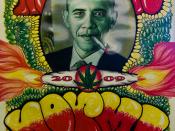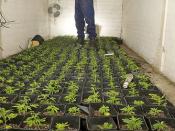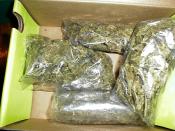Marijuana abuse among teenagers today leads to more serious drug use and directly contributes to the decreasing graduation rates in our country. Marijuana is a psychoactive product from the hemp plant called Cannabis Sativa. There are over 200 nicknames for marijuana including pot, herb, weed, mary jane, ganja, and chronic. The herbal form of the drug consists of dried mature flowers and subtending leaves of pistillate (female) plants. The resinous form, known as hash, or "hashish," consists primarily of glandular trichomes collected from the same material. The major biological active chemical compound in cannabis is "tetrahydrocannibinol," commonly referred to as THC. THC is a fat soluble substance that can remain in the lungs and brain tissue for up to 3 weeks (Carson 1991). Humans have been consuming marijuana since prehistory, although in the 20th century there was a rise in its use for recreational, religious, or spiritual, and medicinal purposes.
The possession, use, or sale of psychoactive cannabis products became illegal in most parts of the world in the early 20th century.
Marijuana is usually smoked by rolling a joint, using a pipe, bong, or vaporizer. Cigars that are emptied of tobacco and refilled with marijuana, sometimes in combination with other drugs are called blunts. Marijuana can also be eaten in food, for example, by baking it in brownies and cookies. Smoking marijuana can relax a person and elevate their mood. This can be followed by drowsiness and sedation. Other effects include heightened sensory awareness, euphoria, altered perceptions and feeling hungry ("the munchies"). High doses of THC may produce a more hallucinogenic response. Marijuana also makes it harder for the body to fight illnesses. It can also harm the heart, lungs, brain, and sex organs. Marijuana contains more cancer-causing agents than cigarettes (Hergert 1991).
Current statistics from the...


